Coastal Evolution, Hydrothermal Migration Pathways and Soft Deformation along the Campania Continental Shelf (Southern Tyrrhenian Sea): Insights from High-Resolution Seismic Profiles
Abstract
:1. Introduction
2. Geologic Framework
3. Methods and Dataset
4. Results
4.1. Seafloor Morphology
4.2. Seismic-Stratigraphic Surfaces and Units Derived from Chirp-Sonar Profiles
4.3. The Stacking Pattern of the Seismic Units by the Sparker Profiles
5. Discussion
5.1. Calibration of Seismic Sections: The Stratigraphic Framework
5.2. Structural Lineaments
5.3. Degassing Features
5.4. Biogenic Gas or Hydrothermal Venting?
5.5. Coastal Evolution
6. Conclusions
Acknowledgments
Author Contributions
Conflicts of Interest
References
- Holbrook, J.; Schumm, S.A. Geomorphic and sedimentary response of rivers to tectonic deformation: A brief review and critique of a tool for recognizing subtle epeirogenic deformation in modern and ancient settings. Tectonophysics 1999, 385, 286–306. [Google Scholar] [CrossRef]
- Aslan, A.; Autin, W.J.; Blum, M.D. Causes of river avulsion: Insights from the late Holocene avulsion history of the Mississippi River, USA. J. Sediment. Res. 2005, 75, 650–664. [Google Scholar] [CrossRef]
- Durán, R.; García-Gil, S.; Diez, R.; Vilas, F. Stratigraphic framework of gas accumulations in the Ría de Pontevedra. Geo-Mar. Lett. 2007, 27, 77–88. [Google Scholar] [CrossRef]
- Mazumdar, A.; Peketi, A.; Dewangan, P.; Badesab, F.; Ramprasad, T.; Ramana, M.V.; Patil, D.J.; Dayal, A. Shallow gas charged sediments off the Indian west coast: Genesis and distribution. Mar. Geol. 2009, 267, 71–85. [Google Scholar] [CrossRef]
- Chun, J.H.; Ryu, B.J.; Lee, C.S.; Kim, Y.J.; Choi, J.Y.; Kang, N.K.; Bahk, J.J.; Kim, J.H.; Kim, K.J.; Yoo, D.G. Factors determining the spatial distribution of gas-charged sediments in the continental shelf off southeastern Korea. Mar. Geol. 2012, 332–334, 27–39. [Google Scholar] [CrossRef]
- Chiocci, F.L. Depositional response to Quaternary fourth-order sea-level fluctuations on the Latium margin (Tyrrhenian Sea, Italy). In Sedimentary Response to Forced Regressions; Hunt, D., Gawthorpe, R.L., Eds.; Geological Society, London, Special Publications: London, UK, 2000; Volume 172, pp. 271–289. ISBN 1862390630. [Google Scholar]
- Iorio, M.; Capretto, G.; Petruccione, E.; Marsella, E.; Aiello, G.; Senatore, M.S. Multi-proxy analysis in defining sedimentary processes in very recent prodelta deposits: The Northern Phlegraean offshore example (Eastern Tyrrhenian Margin). Rend. Lincei-Sci. Fis. Nat. 2014, 25, 237–254. [Google Scholar] [CrossRef] [Green Version]
- Sacchi, M.; Insinga, D.; Milia, A.; Molisso, F.; Raspini, A.; Torrente, M.; Conforti, A. Stratigraphic signature of the Vesuvius 79 AD event off the Sarno prodelta system, Naples Bay. Mar. Geol. 2005, 222–223, 443–469. [Google Scholar] [CrossRef]
- Budillon, F.; Senatore, M.R.; Insinga, D.D.; Iorio, M.; Lubritto, C.; Roca, M.; Rumolo, P. Late Holocene sedimentary changes in shallow water settings: the case of the Sele river offshore in the Salerno Gulf (south-eastern Tyrrhenian Sea, Italy). Rend. Lincei-Sci. Fis. Nat. 2012, 23, 25–43. [Google Scholar] [CrossRef]
- Imbrie, J.; Hays, J.D.; Martinson, D.G.; McIntyre, A.; Mix, A.C.; Morley, J.J.; Pisias, N.G.; Prell, W.L.; Shackleton, N.J. The orbital theory of Pleistocene climate: Support from a revised chronology of the marine d18O record. In Milankovitch and Climate; Berger, A., Imbrie, J., Hays, J.D., Kukla, G., Saltzman, B., Eds.; D. Reidel: Dordrecht, The Netherlands, 1984; Part 1; pp. 289–305. [Google Scholar]
- Posamentier, H.W.; Allen, G.P. Variability of the sequence stratigraphic model: Effects of local basin factors. Sediment. Geol. 1993, 86, 91–109. [Google Scholar] [CrossRef]
- Swift, D.J.P. Coastal erosion and transgressive stratigraphy. J. Geol. 1968, 76, 444–456. [Google Scholar] [CrossRef]
- Cattaneo, A.; Steel, R.J. Transgressive deposits: A review of their variability. Earth Sci. Rev. 2003, 62, 187–228. [Google Scholar] [CrossRef]
- Catuneanu, O.; Abreu, V.; Bhattacharya, J.P.; Blum, M.D.; Dalrymple, R.W.; Eriksson, P.G.; Winker, C. Towards the standardization of sequence stratigraphy. Earth Sci. Rev. 2009, 92, 1–33. [Google Scholar] [CrossRef]
- Smith, L.; Forster, C.; Evans, J. Interaction of fault zones, fluid flow, and heat transfer at the basin scale. In Hydrogeology of Low Permeability Environments: From a Special Symposium at the 28th International Geological Congress, Washington, DC, USA, 9–19 July 1989; Neuman, S.P., Neretnieks, I., Eds.; Hydrogeology; Verlag Heinz Heise: Hanover, Germany, 1990; Volume 2, pp. 41–67. ISBN 3-922705-61-8. [Google Scholar]
- Caine, J.S.; Evans, J.P.; Forster, C.B. Fault zone architecture and permeability structure. Geology 1996, 24, 1025–1028. [Google Scholar] [CrossRef]
- Norton, D.; Knapp, R. Transport phenomena in hydrothermal systems: The nature of porosity. Am. J. Sci. 1977, 22, 913–936. [Google Scholar] [CrossRef]
- Henley, R.W.; Adams, D.P.M. Strike-slip fault reactivation as a control on epithermal vein-style gold mineralization. Geology 1992, 20, 443–446. [Google Scholar] [CrossRef]
- Andresen, K.J. Fluid flow features in hydrocarbon plumbing systems: What do they tell us about the basin evolution? Mar. Geol. 2012, 332–334, 89–108. [Google Scholar] [CrossRef]
- Hustoft, S.; Bunz, S.; Mienert, J. Three-dimensional seismic analysis of the morphology and spatial distribution of chimneys beneath the Nyegga pockmark field, offshore mid-Norway. Basin Res. 2010, 22, 465–480. [Google Scholar] [CrossRef]
- Judd, A.G.; Hovland, M. Seabed Fluid Flow: The Impact on Geology, Biology and the Marine Environment; University Press: Cambridge, UK, 2007; 475p, ISBN 9781139461603. [Google Scholar]
- Martínez-Carreño, N.; García-Gil, S. The Holocene gas system of the Ría de Vigo (NWSpain): Factors controlling the location of gas accumulations, seeps and pockmarks. Mar. Geol. 2013, 344, 82–100. [Google Scholar] [CrossRef]
- Chappell, J.; Shackleton, N.J. Oxygen isotopes and sea level. Nature 1986, 324, 137–140. [Google Scholar] [CrossRef]
- Hunt, D.; Tucker, M.E. Stranded parasequences and the forced regressive wedge systems tract: Deposition during base-level fall. Sediment. Geol. 1992, 81, 1–9. [Google Scholar] [CrossRef]
- Amore, F.O.; Ciampo, G.; Di Donato, V.; Esposito, P.; Pennetta, M.; Russo Ermolli, E.; Staiti, D.; Valente, A. A multidisciplinary study of Late Pleistocene-Holocene sediments of the Gaeta bay continental shelf. Il Quaternario 1996, 9, 521–532. [Google Scholar]
- Coppa, M.G.; Ferraro, L.; Pennetta, M.; Russo, B.; Valente, A.; Secchione, C. Sedimentology and micropaleontology of the core G39-C27 (Gaeta bay, central Tyrrhenian Sea, Italy). Il Quaternario 1996, 9, 687–696. [Google Scholar]
- Aiello, G.; Marsella, E.; Sacchi, M. Quaternary structural evolution of the Terracina and Gaeta basins (Eastern Tyrrhenian margin, Italy). Rend. Lincei-Sci. Fis. Nat. 2000, 11, 41–58. [Google Scholar] [CrossRef]
- Aiello, G.; Insinga, D.D.; Iorio, M.; Meo, A.; Senatore, M.R. On the occurrence of the Neapolitan Yellow Tuff tephra in the Northern Plegraean Fields offshore (Eastern Tyrrhenian margin; Italy). Ital. J. Geosci. 2017, 136. [Google Scholar] [CrossRef]
- Shackleton, N.J. Oxygen isotopes, ice volume and sea level. Quat. Sci. Rev. 1987, 6, 183–190. [Google Scholar] [CrossRef]
- Milia, A.; Torrente, M.M. Late Quaternary volcanism and transtensional tectonics in the Bay of Naples, Campanian continental margin, Italy. Miner. Petrol. 2003, 79, 49–65. [Google Scholar] [CrossRef]
- Moussat, E.; Rehault, J.P.; Fabbri, A. Rifting et évolution tectono-sédimentaire du Bassin Tyrrhénien au cours du Néogène et du Quaternaire. G. Geol. Ser. 1986, 48, 41–62. [Google Scholar]
- Sartori, R. The main results of ODP Leg 107 in the frame of Neogene to Recent geology of the Peri-Tyrrhenian areas. In Proceedings of ODP, Scientific Results; Kastens, A., Mascle, K.J., Eds.; Ocean Drilling Program: College Station, TX, USA, 1990; Volume 107, pp. 715–730. [Google Scholar]
- Hippolyte, J.C.; Angelier, J.; Roure, F. A major geodynamic change revealed by Quaternary stress pattern in the Southern Apennines. Tectonophysics 1994, 230, 199–210. [Google Scholar] [CrossRef]
- Cinque, A.; Patacca, E.; Scandone, P.; Tozzi, M. Quaternary kinematic evolution of the Southern Apennines. Annali Geofisica 1993, 36, 249–260. [Google Scholar]
- Caiazzo, C.; Ascione, A.; Cinque, A. Late Tertiary–Quaternary tectonics of the Southern Apennines (Italy): New evidences from the Tyrrhenian slope. Tectonophysics 2006, 421, 23–51. [Google Scholar] [CrossRef]
- Milia, A. Aggrading and prograding infill of a peri-Tyrrhenian Basin (Naples Bay, Italy). Geo-Mar. Lett. 1999, 19, 237–244. [Google Scholar] [CrossRef]
- Milia, A.; Torrente, M.M.; Massa, B.; Iannace, P. Possible changes in rifting directions in the Campania margin (Italy): New constrains for the Tyrrhenian sea opening. Glob. Planet. Chang. 2013, 109, 3–17. [Google Scholar] [CrossRef]
- Romano, P.; Santo, A.; Voltaggio, M. L’evoluzione geomorfologica della pianura del F. Volturno (Campania) durante il tardo Quaternario (Pleistocene medio-superiore—Olocene). Il Quaternario 1994, 7, 41–56. [Google Scholar]
- Amato, V.; Aucelli, P.P.C.; Cinque, A.; D’Argenio, B.; Di Donato, V.; Russo Ermolli, E.; Pappone, G.; Petrosino, P.; Rosskopf, C.M. Holocene palaeo-geographical evolution of the Sele river coastalplain (Southern Italy): New morpho-sedimentary data from the Paestum area. IL Quaternario 2011, 24, 5–7. [Google Scholar]
- Torrente, M.M.; Milia, A.; Bellucci, F.; Rolandi, G. Extensional tectonics in the Campania Volcanic Zone (eastern Tyrrhenian Sea, Italy): New insights into the relationship between faulting and ignimbrite eruptions. Ital. J. Geosci. 2010, 129, 297–315. [Google Scholar]
- Rosi, M.; Sbrana, A. Phlegrean Fields; CNR, Quaderni Ricerca Scientifica: Rome, Italy, 1987; Volume 9, 176p. [Google Scholar]
- De Vivo, B.; Rolandi, G.; Gans, P.B.; Calvert, A.; Bohrson, W.A.; Spera, F.J.; Belkin, H.E. New constraints on the pyroclastic eruptive history of the Campanian volcanic plain (Italy). Mineral. Petrol. 2001, 73, 47–65. [Google Scholar] [CrossRef]
- Milia, A.; Torrente, M.M. Fold uplift and syn-kinematic stratal architectures in a region of active transtensional tectonics and volcanism, Eastern Tyrrhenian Sea. Geol. Soc. Am. Bull. 2000, 112, 733–747. [Google Scholar] [CrossRef]
- Acocella, V.; Faccenna, C.; Funiciello, R. Elementi strutturali della media Valle Latina. Boll. Soc. Geol. Ital. 1996, 115, 501–518. [Google Scholar]
- De Rita, D.; Giordano, G. Volcanological and structural evolution of Roccamonfina volcano (Italy): Origin of the summit caldera. In Volcano Instability on the Earth and Other Planets; McGuire, W.J., Jones, A.P., Neuberg, J., Eds.; Geological Society Special Publications: London, UK, 1996; Volume 110, pp. 209–224. [Google Scholar]
- De Rita, D.; Funiciello, R.; Pantosti, D.; Salvini, F.; Sposato, A.; Velonà, M. Geological and structural characteristics of the Pontine Islands (Italy) and implications with the evolution of the Tyrrhenian margin. Mem Soc. Geol. Ital. 1986, 36, 55–65. [Google Scholar]
- Di Brozolo, F.R.; Di Girolamo, P.; Turi, B.; Oddone, M. 40Ar-39Ar e K-Ar dating of K-rich rocks from the Roccamonfina Volcano, Roman Comagmatic Region, Italy. Geochim. Cosmochim. Acta 1988, 52, 1435–1441. [Google Scholar] [CrossRef]
- Torrente, M.M.; Milia, A. Volcanism and faulting of the Campania margin (Eastern Tyrrhenian Sea, Italy): A three-dimensional visualization of a new volcanic field off Campi Flegrei. Bull. Volcanol. 2013, 75, 1–13. [Google Scholar] [CrossRef]
- Di Girolamo, P.; Ghiara, M.R.; Lirer, L.; Munno, R.; Rolandi, G.; Stanzione, D. Vulcanologia e petrologia dei Campi Flegrei. Boll. Soc. Geol. Ital. 1984, 103, 349–413. [Google Scholar]
- Deino, A.L.; Orsi, G.; Piochi, M.; de Vita, S. The age of the Neapolitan Yellow Tuff caldera-forming eruption (Campi Flegrei caldera—Italy) assessed by 40Ar/39Ar dating method. J. Volcanol. Geotherm. Res. 2004, 133, 157–170. [Google Scholar] [CrossRef]
- Bigi, G.; Cosentino, D.; Parotto, M.; Sartori, R.; Scandone, P. Structural Model of Italy; Scale 1:500,000; Quaderni de “La Ricerca Scientifica”; Consiglio Nazionale delle Ricerche (CNR): Firenze, Italy, 1992. [Google Scholar]
- Ferraro, L.; Giordano, L.; Iengo, A.; Bonomo, S.; Cascella, A.; Di Martino, G.; Innangi, S.; Tonielli, R.; Gherardi, S.; Tamburrino, S.; et al. Experiences of integrated monitoring of a marine-coastal area: The Volturno River mouth. Quad. Geofis. 2017, 146, 1–70. [Google Scholar]
- Innangi, S.; Barra, M.; Di Martino, G.; Parnum, I.M.; Tonielli, R.; Mazzola, S. Reson SeaBat 8125 backscatter data as a tool for seabed characterization (Central Mediterranean, Southern Italy): Results from different processing approaches. Appl. Acoust. 2015, 87, 109–122. [Google Scholar] [CrossRef]
- Margaritelli, G.; Vallefuoco, M.; Di Rita, F.; Capotondi, L.; Bellucci, L.G.; Insinga, D.D.; Petrosino, P.; Bonomo, S.; Cacho, I.; Cascella, A.; et al. Marine response to climate changes during the last five millennia in the central Mediterranean Sea. Glob. Planet. Chang. 2016. [Google Scholar] [CrossRef]
- Patruno, S.; Hampson, G.J.; Jackson, C.A.-L. Quantitative characterisation of deltaic and subaqueous clinoforms. Earth Sci. Rev. 2015, 142, 79–119. [Google Scholar] [CrossRef]
- Chiocci, F.L.; Casalbore, D. Submarine gullies on Italian upper slopes and their relationship with volcanic activity revisited 20 years after Bill Normark’s pioneering work. Geosphere 2011, 7, 1284–1293. [Google Scholar] [CrossRef]
- Amorosi, A.; Pacifico, A.; Rossi, V.; Ruberti, D. Late Quaternary incision and deposition in an active volcanic setting: The Volturno valley fill, southern Italy. Sediment. Geol. 2012, 282, 307–320. [Google Scholar] [CrossRef]
- Lobo, F.J.; Tesson, M.; Gensous, B. Stratal architectures of late Quaternary regressive transgressive cycles in the Roussillon Shelf (SW Gulf of Lions, France). Mar. Pet. Geol. 2004, 21, 1181–1203. [Google Scholar] [CrossRef]
- Grant, K.M.; Rohling, E.J.; Bar-Matthews, M.; Ayalon, A.; Medina-Elizalde, M.; Bronk Rampsey, C.; Satow, C.; Roberts, A.P. Rapid coupling between ice volume and polar temperature over the past 150,000 years. Nature 2012, 491, 745–747. [Google Scholar] [CrossRef] [PubMed]
- De Alteriis, G.; Fedi, M.; Passaro, S.; Siniscalchi, A. Magneto-seismic interpretation of subsurface volcanism in the Gaeta Gulf (Italy, Tyrrhenian Sea). Ann. Geophys. 2006, 49, 929–943. [Google Scholar]
- Gibbs, A.D. Structural evolution of extensional basin margins. J. Geol. Soc. 1984, 141, 609–620. [Google Scholar] [CrossRef]
- Peacock, D.C.P.; Sanderson, D.J. Geometry and development of relay ramps in normal fault systems. Am. Assoc. Pet. Geol. Bull. 1994, 78, 147–165. [Google Scholar]
- Rowland, J.V.; Sibson, R.H. Extensional fault kinematics within the Taupo Volcanic Zone, New Zealand: Soft-linked segmentation of a continental rift system. N. Z. J. Geol. Geophys. 2001, 44, 271–284. [Google Scholar] [CrossRef]
- Gawthorpe, R.L.; Hurst, J.M. Transfer zones in extensional basins: Their structural style and influence on drainage development and stratigraphy. J. Geol. Soc. 1993, 150, 1137–1152. [Google Scholar] [CrossRef]
- Trudgill, B.; Cartwright, J. Relay-ramp forms and normal-fault linkages, Canyonlands National Park, Utah. Geol. Soc. Am. Bull. 1994, 106, 1143–1157. [Google Scholar] [CrossRef]
- Morley, C.K.; Nelson, R.A.; Patton, T.L.; Munn, S.G. Transfer zones in the East African Rift system and their relevance to hydrocarbon exploration in rifts. Am. Assoc. Pet Geol. Bull. 1990, 74, 1234–1253. [Google Scholar]
- Faulds, J.E.; Varga, R.J. The role of accommodation zones and transfer zones in the regional segmentation of extended terranes. Geol. Soc. Am. Spec. Pap. 1998, 323, 1–45. [Google Scholar]
- Lister, G.S.; Etheridge, M.A.; Symonds, P.A. Detachment faulting and the evolution of passive continental margins. Geology 1986, 14, 246–250. [Google Scholar] [CrossRef]
- Walsh, J.J.; Watterson, J. Geometric and kinematic coherence and scale effects in normal fault systems. In The Geometry of Normal Faults; Roberts, A.M., Yielding, G., Freeman, B., Eds.; Geological Society of London Special Publication: London, UK, 1991; Volume 56, pp. 193–206. ISBN 0-903317-59-1. [Google Scholar]
- McClay, K.; Khalil, S. Extensional hard linkages, eastern Gulf of Suez, Egypt. Geology 1998, 26, 563–566. [Google Scholar] [CrossRef]
- Gay, A.; Lopez, M.; Ondreas, H.; Charlou, J.-L.; Sermondadaz, G.; Cochonat, P. Seafloor facies related to upward methane flux within a Giant Pockmark of the Lower Congo Basin. Mar. Geol. 2006, 226, 81–95. [Google Scholar] [CrossRef]
- Pilcher, R.; Argent, J. Mega-pockmarks and linear pockmark trains on the West African continental margin. Mar. Geol. 2007, 244, 15–32. [Google Scholar] [CrossRef]
- Wilkens, R.H.; Richardson, M.D. The influence of gas bubbles on sediment acoustic properties: In situ, laboratory, and theoretical results from Eckernförde Bay, Baltic sea. Cont. Shelf Res. 1998, 18, 1859–1892. [Google Scholar] [CrossRef]
- Cartwright, J.; Huuse, M.; Aplin, A. Seal bypass systems. AAPG Bull. 2007, 91, 1141–1166. [Google Scholar] [CrossRef]
- Trude, J.; Cartwright, J.; Davies, R.J.; Smallwood, J. New technique for dating igneous sills. Geology 2003, 31, 813–816. [Google Scholar] [CrossRef]
- Milia, A.; Torrente, M.M. Evoluzione tettonica della Penisola Sorrentina (Margine Peritirrenico Campano). Boll. Soc. Geol. Ital. 1997, 116, 487–502. [Google Scholar]
- Bruno, P.P.; Di Fiore, V.; Ventura, G. Seismic study of the ‘41st parallel’ Fault System offshore the Campanian-Latial continental margin, Italy. Tectonophysics 2000, 324, 37–55. [Google Scholar] [CrossRef]
- Cuffaro, M.; Martorelli, E.; Bosman, A.; Conti, A.; Bigi, S.; Muccini, F.; Cocchi, L.; Ligi, M.; Bortoluzzi, G.; Scrocca, D.; et al. The Ventotene Volcanic Ridge: A newly explored complex in the central Tyrrhenian Sea (Italy). Bull. Volcanol. 2016, 78, 2–19. [Google Scholar] [CrossRef]
- Cuoco, E.; Minissale, A.; Di Leo, A.; Tamburrino, S.; Iorio, M.; Tedesco, D. Fluid geochemistry of the Mondragone hydrothermal systems (southern Italy): Water and gas compositions vs. geostructural setting. Int. J. Earth Sci. 2017, 106, 2429–2444. [Google Scholar] [CrossRef]
- Belknap, D.F.; Kraft, J.C. Preservation potential of transgressive coastal lithosomes on the U.S. Atlantic shelf. Mar. Geol. 1981, 42, 429–442. [Google Scholar] [CrossRef]
- Trincardi, F.; Correggiari, A.; Roveri, M. Late Quaternary transgressive erosion and deposition in a modern epicontinental shelf: The Adriatic Semi-enclosed Basin. Geo-Mar. Lett. 1994, 14, 41–51. [Google Scholar] [CrossRef]
- Amorosi, A.; Milli, S. Late Quaternary depositional architecture of Po and Tevere river deltas (Italy): A worldwide comparison with coeval deltaic successions. Sediment. Geol. 2001, 144, 357–375. [Google Scholar] [CrossRef]
- Storms, J.E.A.; Weltje, G.J.; Terra, G.J.; Cattaneo, A.; Trincardi, F. Coastal dynamics under conditions of rapid sea-level rise: Late Pleistocene to Early Holocene evolution of barrier-lagoon systems on the northern Adriatic shelf (Italy). Quat. Sci. Rev. 2008, 27, 1107–1123. [Google Scholar] [CrossRef]
- Miall, A.D. The Geology of Fluvial Deposits; Springer: Berlin/Heidelberg, Germany, 1996. [Google Scholar]
- Jones, L.S.; Schumm, S.A. Causes of avulsion: An overview. Spec. Publ. Ass. Sediment 1999, 28, 171–178. [Google Scholar]
- Grapes, R.H.; Reid, D.L.; McPherson, J.G. Shallow dolerite intrusions and phreatic eruption in the Allan Hills region, Antarctica. N. Z. J. Geol. Geophys. 1973, 17, 563–577. [Google Scholar] [CrossRef]
- Einsele, G. Mechanism of Sill Intrusion into Soft Sediment and Expulsion of Pore Water; Initial Reports for Deep Sea Drilling Project 1982; Geologisches Institut der Universitàt Tubingen: Tubingen, Germany, 1982; pp. 1169–1176. [Google Scholar]
- Krynauw, J.R.; Hunter, D.R.; Wilsona, H. Emplacement of sills into wet sediments at Grunehogna, western Dronning Maud Land, Antarctica. J. Geol. Soc. 1988, 145, 1019–1032. [Google Scholar] [CrossRef]
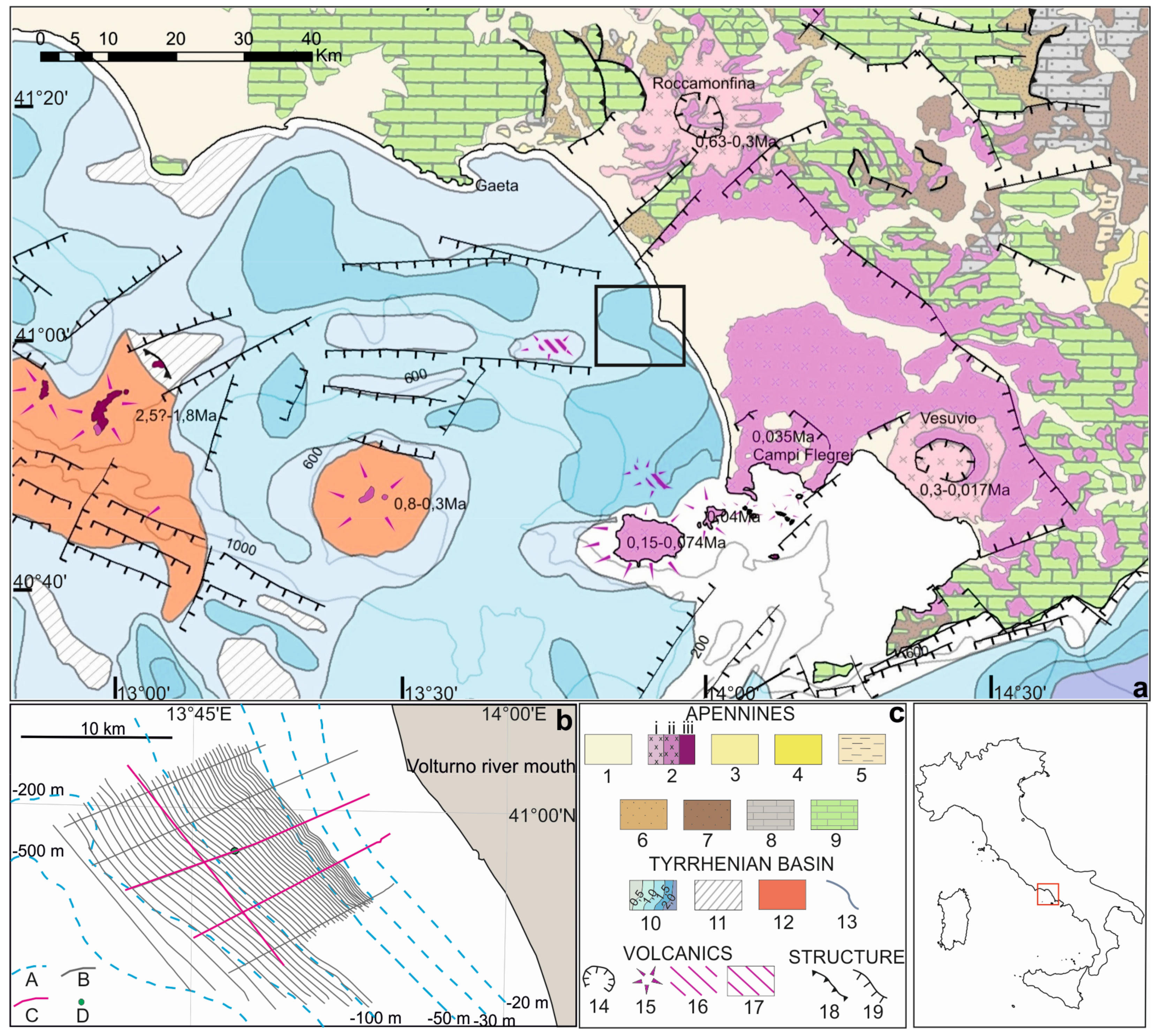
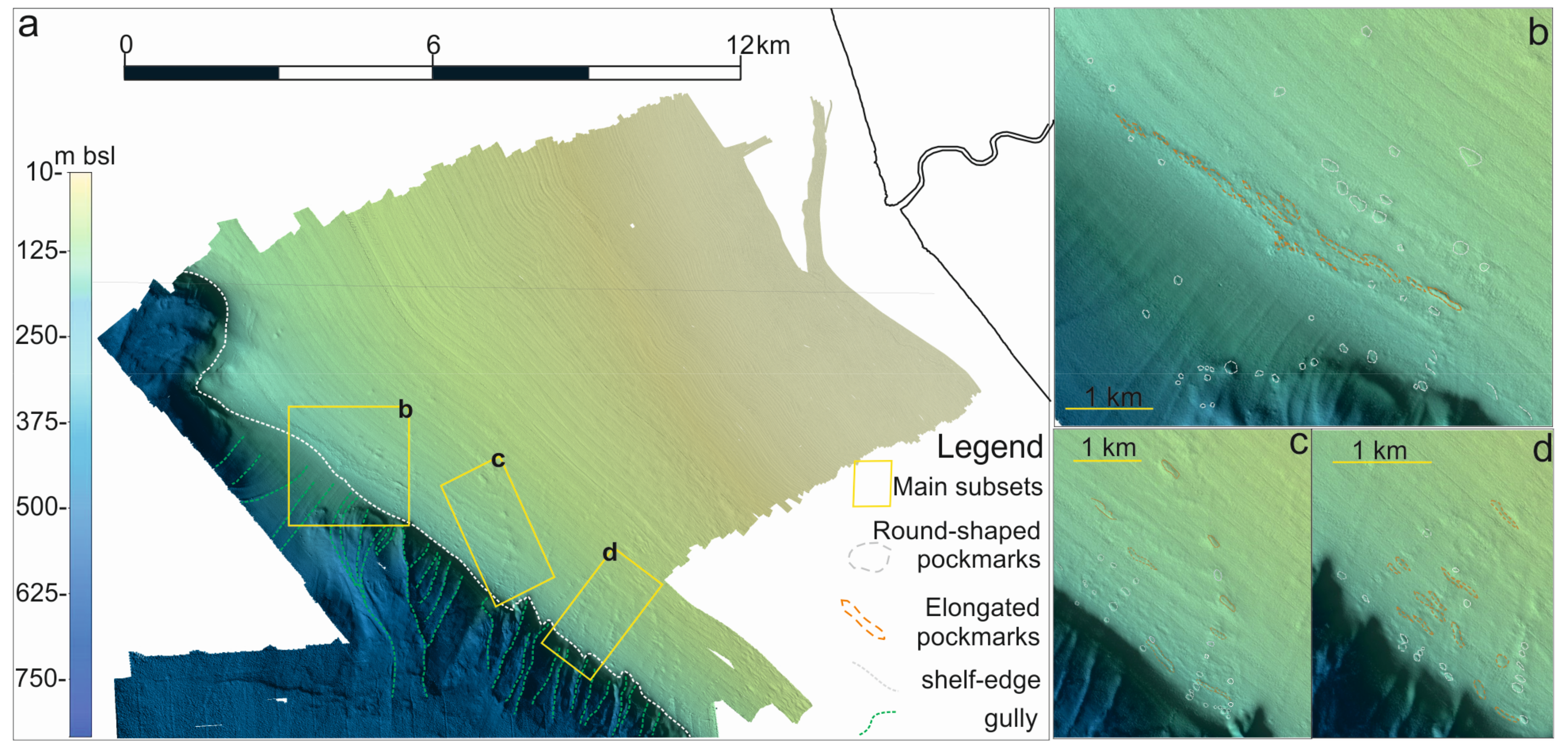
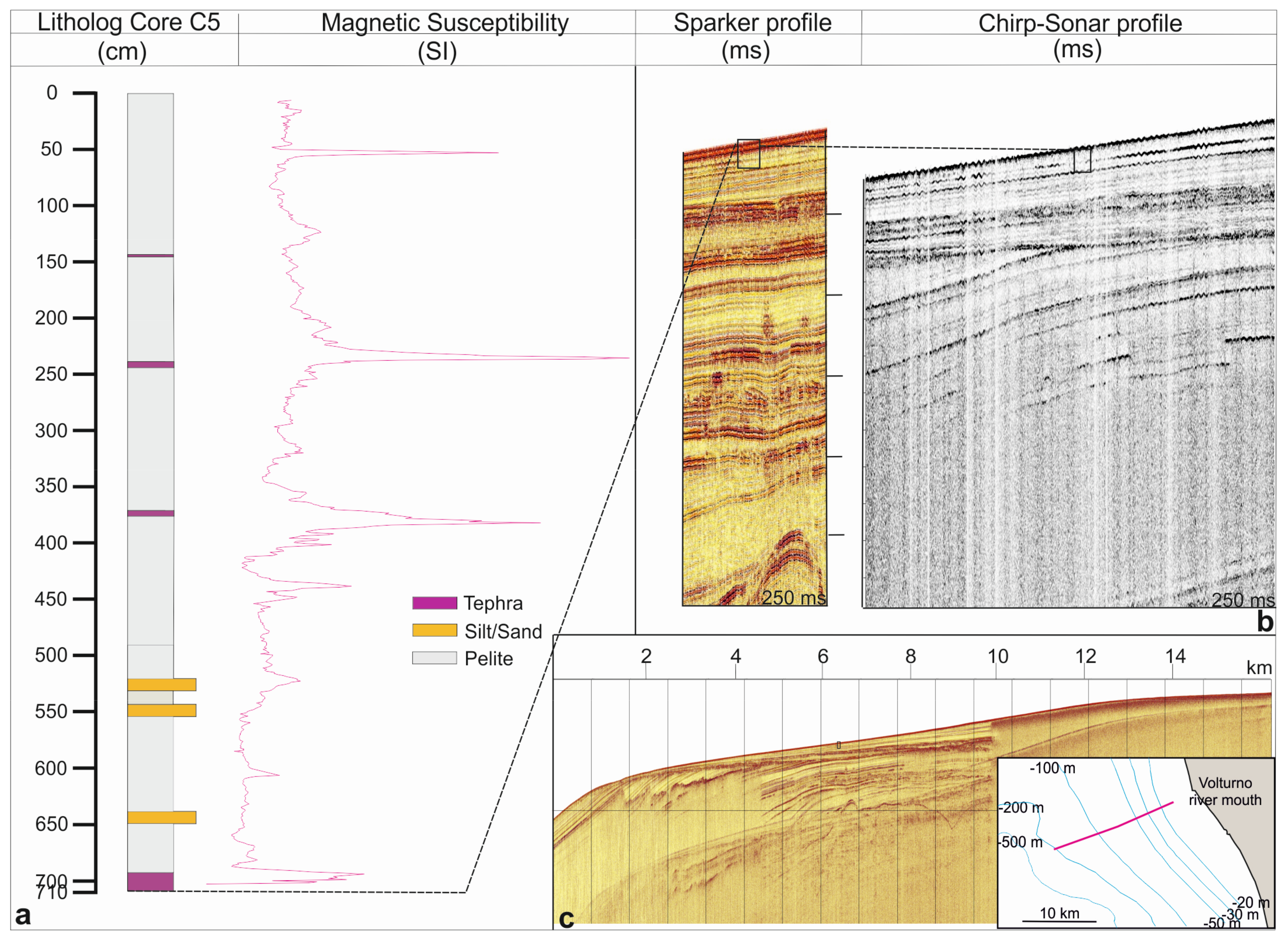

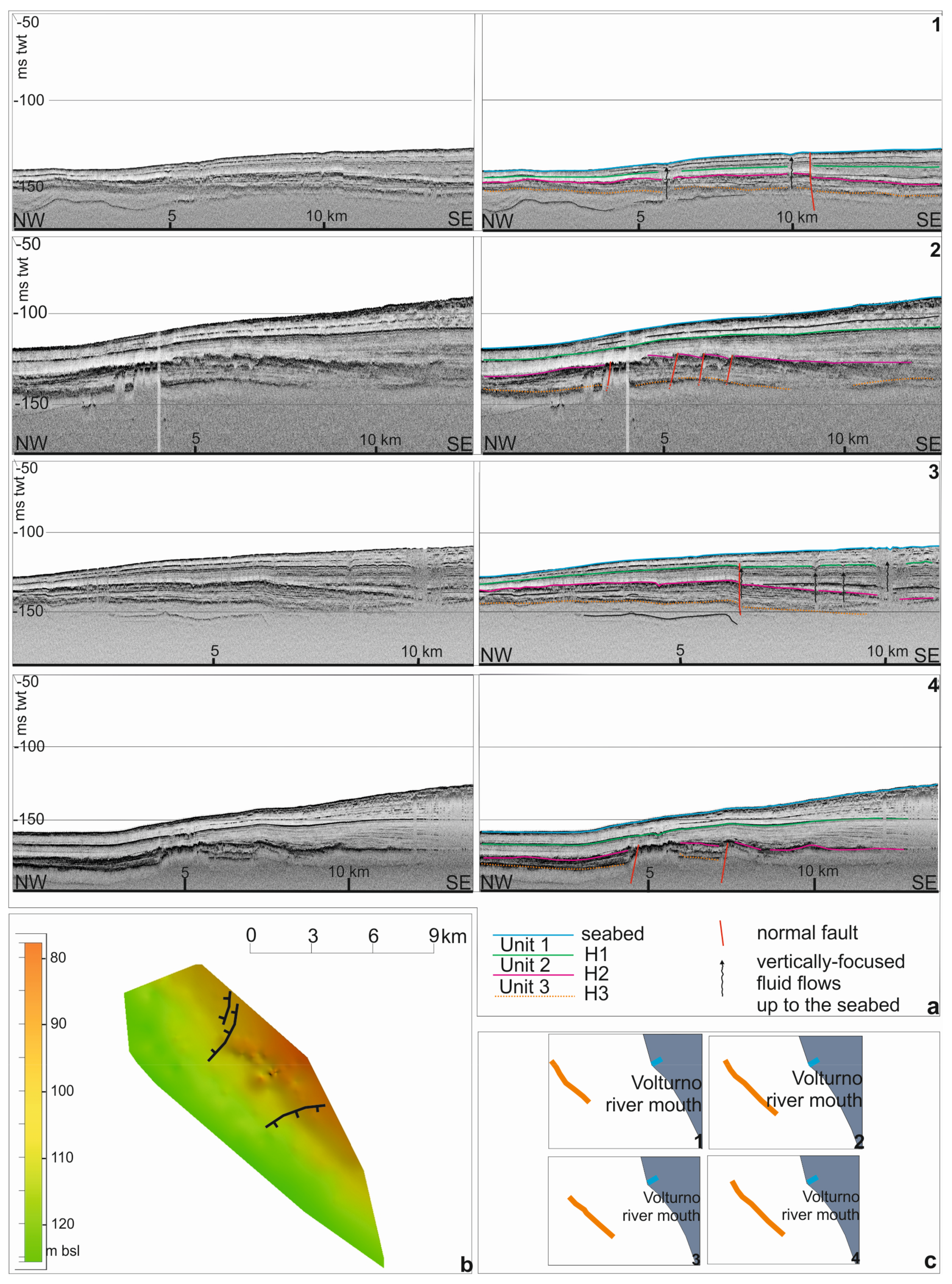
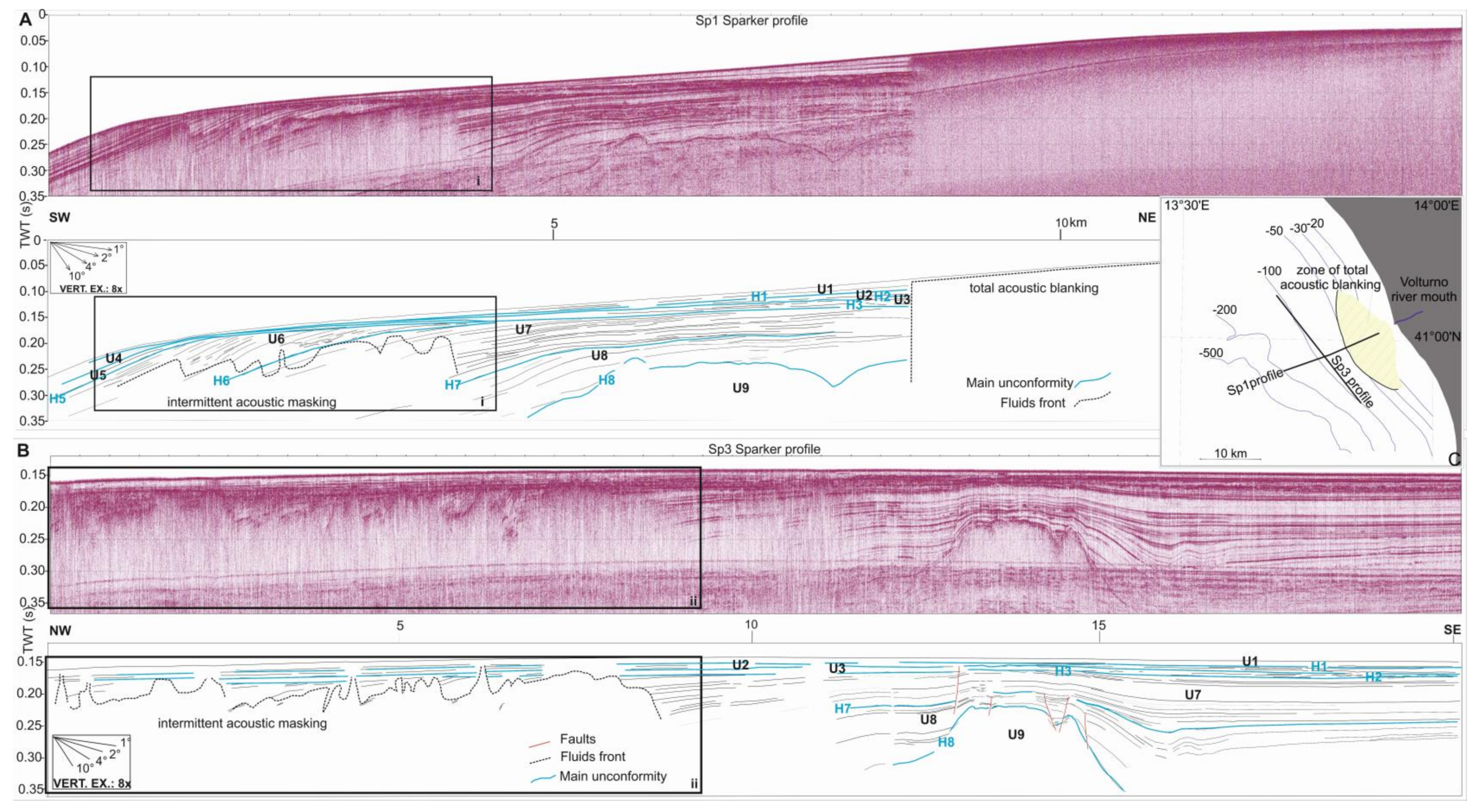
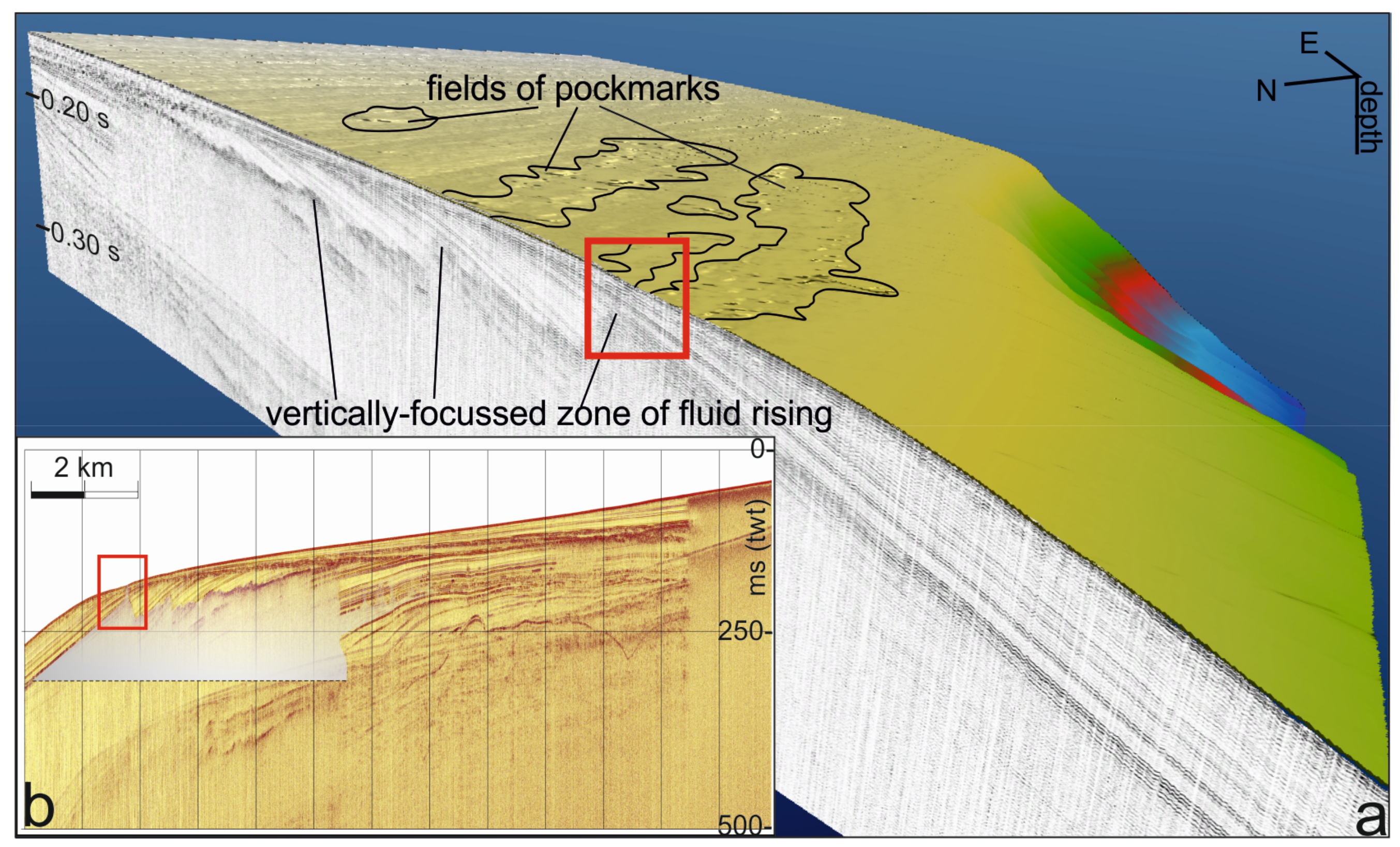


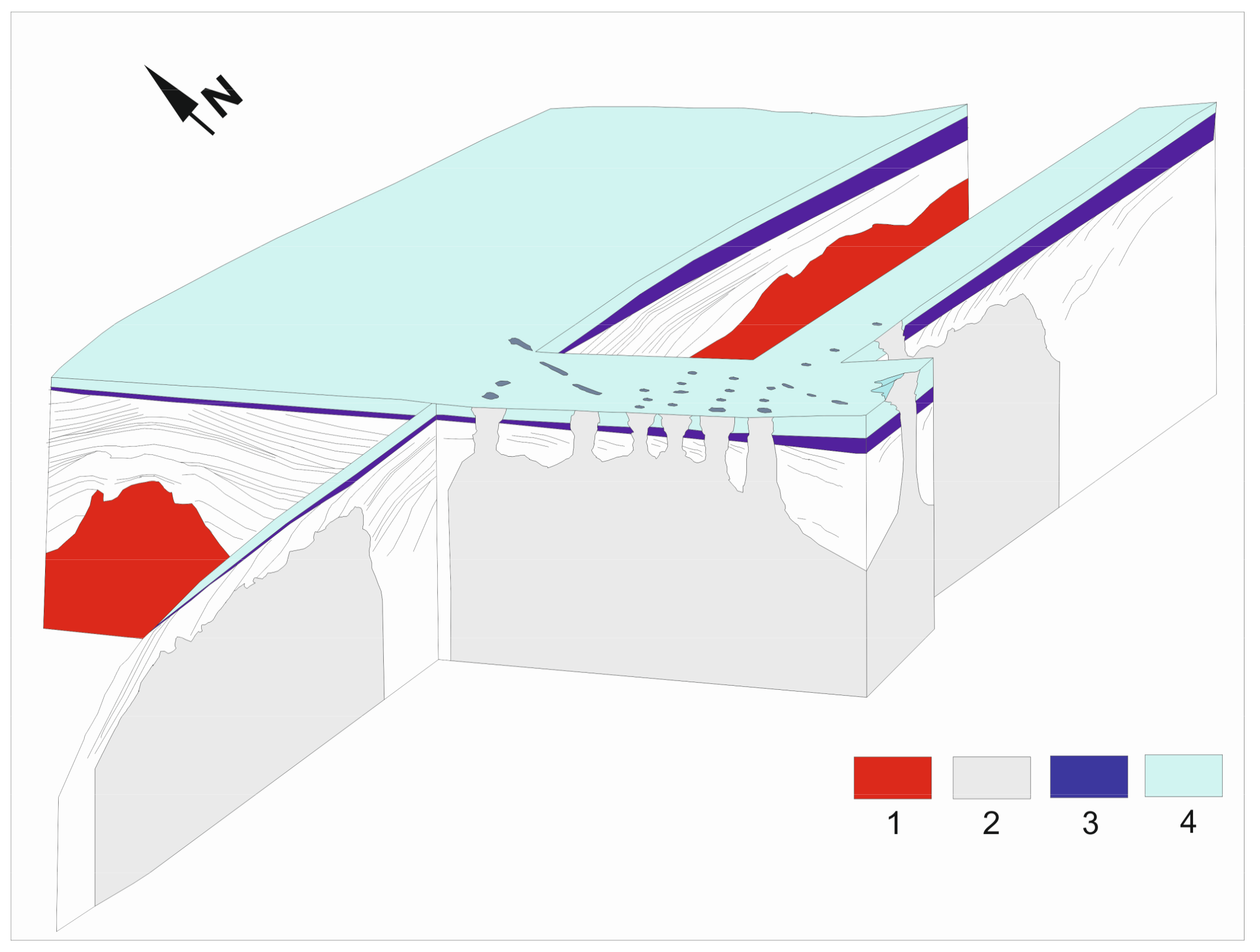
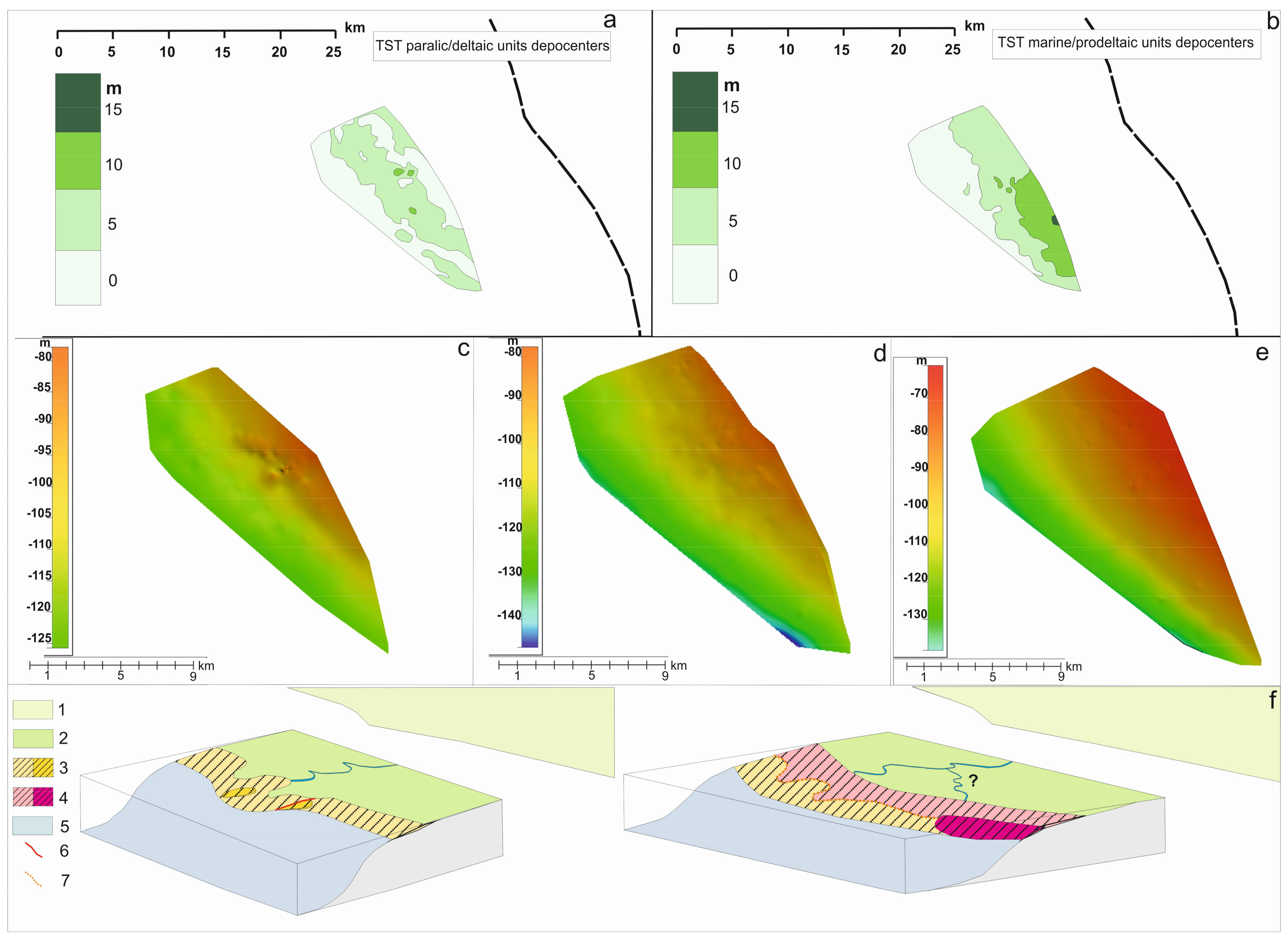
© 2018 by the authors. Licensee MDPI, Basel, Switzerland. This article is an open access article distributed under the terms and conditions of the Creative Commons Attribution (CC BY) license (http://creativecommons.org/licenses/by/4.0/).
Share and Cite
Misuraca, M.; Budillon, F.; Tonielli, R.; Di Martino, G.; Innangi, S.; Ferraro, L. Coastal Evolution, Hydrothermal Migration Pathways and Soft Deformation along the Campania Continental Shelf (Southern Tyrrhenian Sea): Insights from High-Resolution Seismic Profiles. Geosciences 2018, 8, 121. https://doi.org/10.3390/geosciences8040121
Misuraca M, Budillon F, Tonielli R, Di Martino G, Innangi S, Ferraro L. Coastal Evolution, Hydrothermal Migration Pathways and Soft Deformation along the Campania Continental Shelf (Southern Tyrrhenian Sea): Insights from High-Resolution Seismic Profiles. Geosciences. 2018; 8(4):121. https://doi.org/10.3390/geosciences8040121
Chicago/Turabian StyleMisuraca, Martina, Francesca Budillon, Renato Tonielli, Gabriella Di Martino, Sara Innangi, and Luciana Ferraro. 2018. "Coastal Evolution, Hydrothermal Migration Pathways and Soft Deformation along the Campania Continental Shelf (Southern Tyrrhenian Sea): Insights from High-Resolution Seismic Profiles" Geosciences 8, no. 4: 121. https://doi.org/10.3390/geosciences8040121






